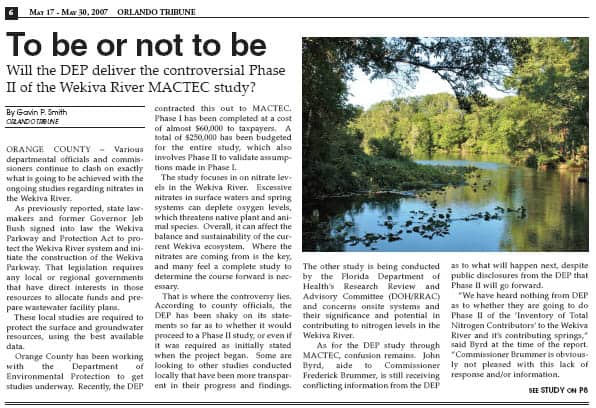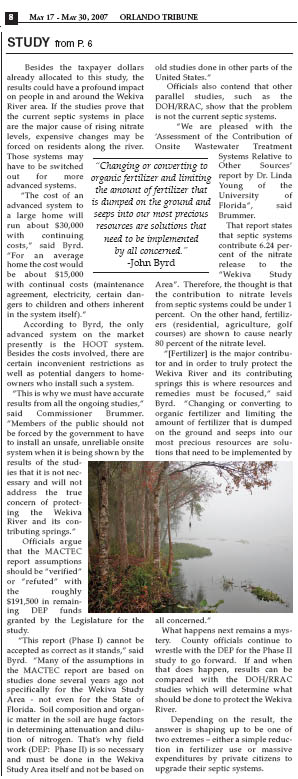
ORANGE COUNTY – Since the last issue of the Orlando Tribune, the top controversial story in Orange County continues to be the Wekiva River study. Various departmental officials and commissioners continue to clash on exactly what is going to be achieved with the ongoing studies regarding nitrates in the Wekiva River.
As previously reported, state lawmakers and former Governor Jeb Bush signed into law the Wekiva Parkway and Protection Act to protect the Wekiva River system and initiate the construction of the Wekiva Parkway. That legislation requires any local or regional governments that have direct interests in those resources to allocate funds and prepare wastewater facilities plans. These local studies are required to protect the surface and groundwater resources, using the best available data.
Orange County has been working with the Department of Environmental Protection to get studies underway. Recently, the DEP contracted this out to MACTEC. Phase I has been completed at a cost of almost $60,000 to taxpayers. A total of $250,000 has been budgeted for the entire study, which also involves Phase II to validate assumptions made in Phase I.
The study focuses in on nitrate levels in the Wekiva River. Excessive nitrates in surface waters and spring systems can deplete oxygen levels, which threatens native plant and animal species. Overall, it can affect the balance and sustainability of the current Wekiva ecosystem. Where the nitrates are coming from is the key. Getting a complete study in order to determine the course forward is needed.
That’s where the controversy begins. According to county officials, the DEP has been shaky on its statements so far as to whether it would proceed to a Phase II study, or even if it was required as initially stated when the project began. Some are looking to other studies conducted locally that have been more transparent in their progress and findings. The other study is being conducted by the Florida Department Of Health’s Research Review and Advisory Committee (DOH/RRAC). That study concerns onsite systems and their significance and potential in contributing to nitrogen levels in the Wekiva River.

As for the DEP study through MACTEC, confusion remains. John Byrd, aide to Commissioner Frederick Brummer, is still receiving conflicting information from the DEP as to what will happen next, despite public disclosures from the DEP that Phase II will go forward.
“As of today (May 7) we have heard “nothing” from DEP as to whether they are going to do Phase II of the “Inventory of Total Nitrogen Contributors” to the Wekiva River and it’s Contributing Springs,” said Byrd. “Commissioner Brummer is obviously not pleased with this lack of response and/or information.”
Why is this study so controversial? Besides the taxpayer dollars already allocated to this study, the results could have a profound impact on people in and around the Wekiva River area. If the studies prove that the current septic systems in place are the major cause of rising nitrate levels, expensive changes may be forced on residents along the river. Those systems may have to be switched out for more “advanced” systems.
“The cost of an “advanced” system to a large home will run about $30,000 with continuing costs,” said Byrd. “For an “average” home the cost would be about $15,000 with continual costs (maintenance agreement, electricity, certain dangers to children and others inherent in the system itself).”
According to Byrd, the only “advanced” system on the market presently is the HOOT system. Besides the costs involved, there are certain inconvenient restrictions as well as potential dangers to homeowners who install such a system.
“This is why we must have accurate results from all the ongoing studies,” said Commissioner Brummer. “Members of the public should not be forced by the government to have to install an unsafe, unreliable onsite system when it is being shown by the results of the studies that it is not necessary and will not address the true concern of protecting the Wekiva River and its contributing springs.”
Officials argue that the MACTEC report assumptions should be “verified” or “refuted” with the remaining $191,509.76 DEP funds granted by the Legislature for the study.
“This report (Phase I) cannot be accepted as correct as it stands,” said Byrd. “Many of the assumptions in the MACTEC report are based on studies done several years ago not specifically for the Wekiva Study Area (not even for the State of Florida). Soil composition and organic matter in the soil are huge factors in determining attenuation and dilution of nitrogen. That’s why field work (DEP: Phase II) is so necessary and must be done in the Wekiva Study Area itself and not be based on old studies done in other parts of the United States.”
Officials also contend that other parallel studies, such as the DOH/RRAC, show that the problem is not the current septic systems. Instead, the problem is much more simplistic.
“We are pleased with the “Assessment of the Contribution of Onsite Wastewater Treatment Systems Relative to Other Sources” report by Dr. Linda Young of the University of Florida”, said Brummer.
That report states that septic systems contribute 6.24% of the nitrate release to the “Wekiva Study Area”. Therefore, the thought is that the contribution to nitrate levels from septic systems could be under 1%. On the other hand, fertilizers (Residential, Agriculture, Golf Courses) are shown to cause nearly 80% of the nitrate level.
“(Fertilizer) is the major contributor and in order to truly protect the Wekiva River and its contributing springs this is where resources and remedies must be focused,” said Byrd. “Changing or converting to organic fertilizer and limiting the amount of fertilizer that is dumped on the ground and seeps into our most precious resources are solutions that need to be implemented by all concerned.”
What happens next continues to be a mystery. County officials continue to wrestle with the DEP for the Phase II study to go forward. If and when that does happen, results can be compared with the DOH/RRAC studies which will determine what should be done to protect the Wekiva River.
Depending on the result, the answer is shaping up to be one of two extremes – either a simple reduction in fertilizer use, or massive expenditures by private citizens to upgrade their septic systems.
